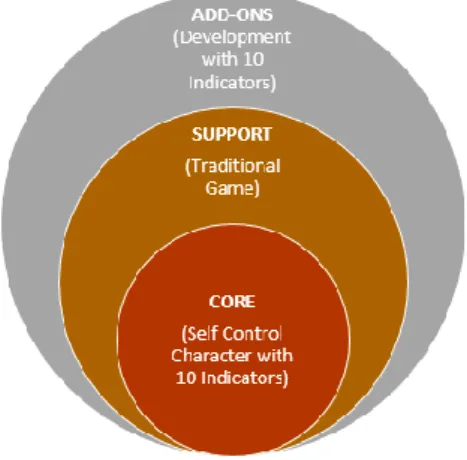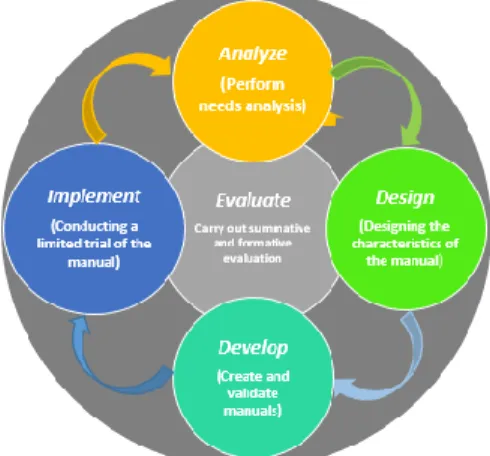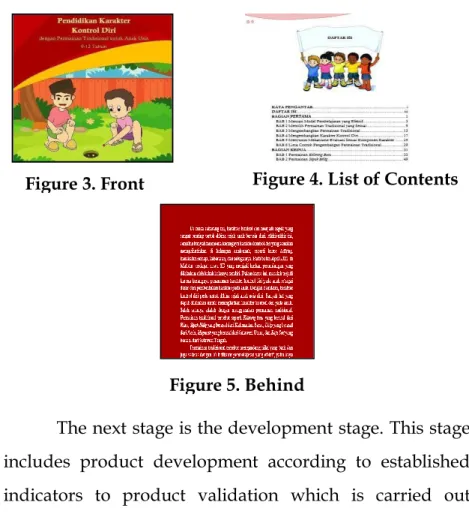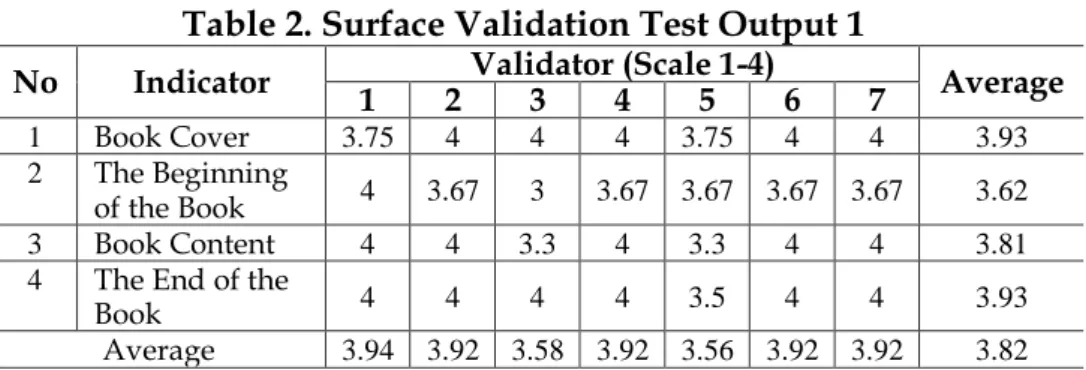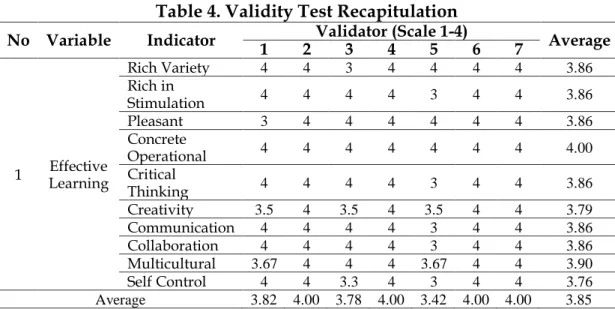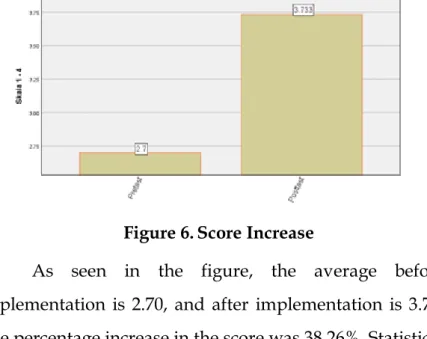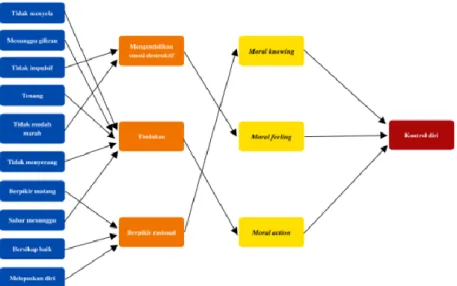THE CONTRIBUTION OF TRADITIONAL GAMES IN ESTABLISHING SELF-CONTROL
CHILDREN
Bernadeta Tri Anjarwati Kusuma Wardani1 Gregorius Ari Nugrahanta2
1,2 Universitas Sanata Dharma, Indonesia Email: 1[email protected]
Approve:
2021-10-31 Review:
2021-11-14 Publish:
2021-12-20
Abstract
This research intended to develop a traditional game guidebook to improve self-control for children aged 9-12.
This research method was R&D. Research conducted involved seven validators for expert judgment, seven teachers who were certified educators for needs analysis, and six children through subjects of a limited trial of the developed traditional game guidebook. The results indicated that; 1) development of this traditional game guidebook using ADDIE, 2) traditional game guidebook belonging to the "Very good" quality strata, with an average of 3.81 (scale 1-4) and consideration "No revision
needed", and 3) implementation of this traditional game guidebook affected self-control. The significance test indicated t(5) = 16.81; p = 0.00 (p < 0.05) and r = 0.99 which belonged in the strata "Big effect" and equivalent to 98.26%. Thus, this traditional game guidebook could interpret 98.26% of changes in the self-control of children. The traditional game guidebook showed the effectiveness of the N-gain score of 80.39% which corresponds to the "High" strata.
Keywords: Self-Control, Traditional Games, Guidebook Abstrak
Riset ini dimaksudkan untuk mengembangkan buku pedoman permainan tradisional dalam meningkatkan kontrol diri anak berumur 9-12 tahun. Riset ini menggunakan metode R & D. Riset yang dilakukan melibatkan tujuh validator untuk expert judgement, tujuh guru bersertifikat untuk analisis kebutuhan, dan enam anak sebagai subjek uji coba terbatas dari buku pedoman permainan tradisional yang dikembangkan.
Hasil dari riset menunjukkan; 1) buku pedoman permainan tradisional ini dikembangkan dengan langkah ADDIE, 2) buku pedoman permainan tradisional tergolong dalam strata kualitas “Sangat baik”, dengan rerata 3,81 (pada skala 1-4) dan pertimbangan “Tidak perlu revisi”, dan 3) implementasi dari buku pedoman permainan tradisional memiliki pengaruh terhadap peningkatan kontrol diri. Uji signifikansi menunjukkan t(5) = 16,81; p = 0,00 (p < 0,05) dengan r = 0,99 tergolong dalam strata “Efek yang besar” dan sepadan dengan
98,26%. Dengan demikian, buku pedoman permainan tradisional bisa menginterpretasikan 98,26% perubahan kontrol diri anak. Efektivitas dari buku pedoman permainan tradisional ini ditunjukkan dengan nilai N- gain score 80,39% sepadan dengan strata “Tinggi”.
Kata Kunci: Kontrol Diri, Permainan Tradisional, Buku Pedoman
Introduction
Character education is an important thing to be nurtured from an early age. Character education is education that lasts a lifetime as a form of the process towards a complete human being, so it is necessary to cultivate it from an early age to adulthood (Rizky &
Astutik, 2021). Character education can lead to social, moral, habituation, and self-development (Putri &
Nugrahanta, 2021). Good character is characterized by knowledge of morals, honest feelings, and moral actions (Lickona, 2012; Kholil et al., 2021). Now the excellent character is gradually disappearing (Amania et al., 2021).
One of these characters is self-control.
The low self-control of children can be seen from the KPAI records, which stated that there were 2,473 cases of bullying in 2011-2019 (KPAI, 2020). The number of cases shows that children's self-control is concerning and needs coaching. The fact that this character is low shows that there is no success in improving the character of humanity (Astuti & Nugrahanta, 2021). Self-control is the primary virtue in moral behavior (Sekarningrum et al., 2021). Self- control is a person's ability to control himself, both his thoughts and actions, so that he can do something well (Sekarningrum et al., 2021). Good self-control is indicated by indicators, not interrupting, waiting for their turn, not being impulsive, calm, not easily angry, not attacking, thinking carefully, patiently waiting, being kind, and letting go.
Self-control can be improved by an effective learning model with a multidimensional approach, namely Brain- Based Learning (BBL), constructivism, 21st-century guidance, and multiculturalism. BBL is learning that pays attention to the natural working method of the brain (Lestari, 2014). Effective learning can improve children's
skills, cognition, attitudes, and enthusiasm for learning (Wijayanti et al., 2021). Children are in a world of play that can train their ability to adapt to the environment (Syihabbudin & Umami, 2021). Thus, traditional games are believed to increase self-control and are compatible with effective learning indicators, namely stimulation, fun, variety, critical thinking, communication, creativity, collaboration, operational-concrete, multicultural, and self- control. Traditional games are hereditary games that are guided by norms and customs that are of good value (Nataliya, 2015; Bali, 2019). Traditional games need to be developed by selecting materials, writing questions, running games, scoring, repeating questions, and conclusions (Sekarningrum et al., 2021).
Several studies are relevant to this research, such as a study on game strategies considered adequate for developing self-control abilities (Suherman, 2016).
Traditional games are also considered to be able to build character in children (Nur, 2013; Bali & Ruzifah, 2021). In addition to games, self-control can also be developed with the application of psychodrama (Sari, 2017). The use of
modeling techniques is also able to increase self-control (Farani et al., 2017). In addition, traditional games can also improve children's social development (Saleh et al., 2017).
Not only that, but traditional games are also able to grow character in children, such as honesty, discipline, cooperation, and social skills (Husain & Walangadi, 2021).
The novelty of this research lies in three elements, namely multidimensional, concentric, and gradual. This research is multidimensional because it uses the BBL approach, 21st-century guidance, constructivism according to Piaget and Vigotsky, and multicultural. This research applies a concentric model with the development of various activities at once to achieve one goal (in finem omnia), which is divided into three areas, namely core (self- control character education), supporting (five traditional games), and add-ons (traditional game development).
Graduality appears in the choice options on a scale of 1-4, starting from non-character, cognitive, affective, and action elements. Here's a picture of the concentric model.
Figure 1. Concentric Model
This research is limited to developing a traditional game manual to improve self-control in children aged 9-12 years. Combining learning materials and traditional games is one way to establish character (Nugraheni et al., 2021). In this research, self-control character education is defined as a person's ability to control himself, both his thoughts and actions, so that he can do something well. The traditional game manual is a valuable book for carrying out traditional games enhanced by the existence of teaching facilities with ten indicators. The research objectives were: 1) development of traditional game guidebooks that are useful in increasing self-control, 2) knowing the quality of
traditional game guidebooks used to improve self-control, and 3) seeing the effect of implementing traditional game guidebooks in improving self-control.
Method
The research uses research development studies (R&D) with the ADDIE style (Analyze, Design, Develop, Implement, and Evaluate). R & D is developing the latest product or improving the previous one (Pratiwi et al., 2021). This research was conducted in Bulu, Wahyuharjo, Lendah, Kulon Progo, Yogyakarta for five days with a limited trial subject involving six children, namely three girls and three boys aged 9-12 years. The development of the ADDIE stage can be seen in the chart below.
Figure 2. ADDIE Model
Analyze is carried out in order to find out the contradiction between the learning that should be implemented and what is actually implemented. This stage is carried out concretely by analyzing needs with closed and open questionnaires to seven teachers who have been certified from different regions, namely from Kulon Progo, Gunungkidul, Bantul, Sleman, and Bekasi.
Design is carried out in order to create a product design as a solution to the problems found. This stage is carried out by designing traditional game manuals by developing indicators of effective learning.
Develop is carried out to develop products that have been designed. This stage was carried out concretely by compiling a manual with traditional games from five different regions, namely Marbles Batu from Riau, Sepak Beleg from West Kalimantan, Letep from Aceh, Mapintih from North Sulawesi, and Baju Soti from Central Sulawesi.
This stage also carried out surface validation and content validation from the manual involving seven experts for expert judgment consisting of one humanist, three lecturers, and three certified teachers.
Implementation is done to apply the manual that has been developed. This stage is carried out with a limited number of children aged 9-12 years as the subject of the research. Children aged 9-12 years were chosen as subjects because that age is included in the early transition period from childhood to early adolescence. Thus, children aged 9-12 years already have signs of wanting to be independent, not wanting to depend on their parents anymore, and there are changes both physically and emotionally. Children's emotions at this age are usually more loose and easy to explode, so it is necessary to guard against the
development of good self-control characters in children.
The last stage is evaluate, which is carried out to assess the quality of the process and results before and after the implementation of activities. This stage is done concretely by giving formative and summative evaluation questions. Summative evaluation questions are given before (pretest) and after (posttest) the implementation of the five games, while formative evaluation questions are given at the end of each game.
The instrument in this research uses both tests and non-tests. The test is structured in multiple choice questions according to indicators of self-control character. This question is distributed in the evaluation stage as a summative and formative evaluation. Nontests are arranged in the form of open and closed questionnaires. An open questionnaire was applied for needs analysis and to find out the increase in the character of self-control in children. Closed questionnaires were applied to carry out needs analysis and validation of the developed products.
Results and Discussion Results
The research results show that the development of traditional game manuals is carried out in the ADDIE stage.
The first stage is analyze. This stage is used to find contradictions between the learning and what is being implemented. This stage was carried out by giving closed and open questionnaires to seven teachers who were certified educators. Based on the data obtained, the average of the needs analysis is 1.93 (scale 1-4). This value is interpreted with guidelines for converting quantitative values into qualitative ones (Widoyoko, 2014).
Table 1. Guidelines for Converting Quantitative to Qualitative Values
No Score Range Category Recommendation 1 3.26 - 4.00 Very good No revision needed 2 2.51 - 3.25 Well Need a small revision 3 1.76 - 2.50 Enough Need major revision 4 1.00 - 1.75 Not enough Needs a complete overhaul
Based on the table, the average of 1.93 belongs to the
"Unfavorable" strata, so it can be seen that there is a contradiction between the learning that should be implemented and the learning that is implemented. The
results of the closed questionnaire are reinforced by the results of the open questionnaire, which states that the efforts made to improve the character of self-control have not gone well and have only used a learning model that involves experience and cooperation only. The difficulty faced in enhancing children's self-control is the lack of media, facilities, infrastructure, and time. From these answers, it can be seen that there are no learning methods and models specifically used to improve self-control in children aged 9-12 years. Thus, there is a solid foundation to offer problem-solving in the form of traditional game playbooks.
This traditional game manual was designed at the design stage. The initial draft of the manual includes a cover, a foreword, and a table of contents. The following section discusses effective learning, BBL, constructivism, the 21st century, and the character of self-control. The theory is used as the basis for determining ten indicators of effective learning. In addition, it also contains five traditional games from different regions, namely Marbles Batu from Riau, Sepak Beleg from West Kalimantan, Letep
from Aceh, Mapintih from North Sulawesi, and Baju Soti from Central Sulawesi. The last part of the manual contains a list of references, pretest, and posttest questions, answer keys, glossary, index, author biodata, and a manual summary. Here are some of the sections in the book.
Figure 3. Front Figure 4. List of Contents
Figure 5. Behind
The next stage is the development stage. This stage includes product development according to established indicators to product validation which is carried out
through seven experts for expert judgment. This validation consists of surface 1, surface 2, and content validation.
Surface validation 1 tested the criteria of the traditional game manual that was compiled, and surface validity test 2 tested the characteristics of the traditional game manual.
The following is the output of the surface validity test 1 (table 2).
Table 2. Surface Validation Test Output 1
No Indicator 1 2 Validator (Scale 1-4) 3 4 5 6 7 Average
1 Book Cover 3.75 4 4 4 3.75 4 4 3.93
2 The Beginning
of the Book 4 3.67 3 3.67 3.67 3.67 3.67 3.62
3 Book Content 4 4 3.3 4 3.3 4 4 3.81
4 The End of the
Book 4 4 4 4 3.5 4 4 3.93
Average 3.94 3.92 3.58 3.92 3.56 3.92 3.92 3.82
Based on the output, the indicator of the book cover and the end of the book got the highest score with an average score of 3.93. The lowest average is at the beginning of the book, with an average value of 3.62. The results of the surface validity test 1 get an average of 3.82. Based on the guideline table (see Table 1), the mean of 3.82 belongs to the
“Very good” strata, and the consideration is “No need for revision”. Next, a surface validity test is carried out. The
following is the output of the surface validity test result 2 (table 3).
Table 3. Surface Validation Test Output 2
No Variable Indicator 1 2 Validator (Scale 1-4) 3 4 5 6 7 Average
1 Character Self
Instructional 4 4 3.3 3.5 3.5 4 4 3.77
Self Contained 4 4 4 4 4 4 4 4.00
Stand Alone 3 4 3 4 3 4 3 3.42
Adaptive 4 4 3 4 3 4 4 3.71
User Friendly 4 4 4 4 3 4 4 3.86
Average 3.80 4.00 3.47 3.90 3.30 4.00 3.80 3.75
From the output, the indicator with the highest average value is in the contained stand with a score of 4.00.
The lowest average score is in stand-alone, with a score of 3.42. The average of the overall surface validity test 2 is 3.75, which, based on the guideline table (see Table 1), belongs to the "Very good" strata, and the consideration is "No need for revision".
Furthermore, the content validity test was also carried out. This test is used to see if the traditional game manual has met the ten indicators of effective learning. The following (table 4) is the output of the content validity test results.
Table 4. Validity Test Recapitulation
No Variable Indicator 1 2 Validator (Scale 1-4) 3 4 5 6 7 Average
1 Effective Learning
Rich Variety 4 4 3 4 4 4 4 3.86
Rich in
Stimulation 4 4 4 4 3 4 4 3.86
Pleasant 3 4 4 4 4 4 4 3.86
Concrete
Operational 4 4 4 4 4 4 4 4.00
Critical
Thinking 4 4 4 4 3 4 4 3.86
Creativity 3.5 4 3.5 4 3.5 4 4 3.79
Communication 4 4 4 4 3 4 4 3.86
Collaboration 4 4 4 4 3 4 4 3.86
Multicultural 3.67 4 4 4 3.67 4 4 3.90
Self Control 4 4 3.3 4 3 4 4 3.76
Average 3.82 4.00 3.78 4.00 3.42 4.00 4.00 3.85
Based on the data, the indicator with the highest score is in concrete operations with a score of 4.00. The indicator with the lowest score is self-control, which is 3.76.
The average of the overall content validity test results is 3.85, which based on the guideline table (see Table 1), belongs to the "Very good" strata, and the consideration is
"No need for revision". The results of the validity test are summarized in the following table 5.
Table 5. Validity Test Recapitulation
No Validation Score Qualification Recommendation 1 Surface Validity
a. Criteria 3.82 Very good No revision needed b. Characteristics 3.75 Very good No revision needed
No Validation Score Qualification Recommendation 2 Content Validity 3.85 Very good No revision needed
Average 3.81 Very good No revision needed
The data above shows that the mean of the overall validity test is 3.81, which based on the guideline table (see Table 1), belongs to the "Very good" strata with the consideration of "No need for revision".
After validating, the next stage is implementing.
This stage is done by testing the game manual that has been developed in a limited way. Implementation through three stages. The first stage is preparation, starting from making letters, asking for permission, preparing tools and materials, making questions, and preparing questionnaires that will be given to children and parents. The second stage is the implementation is carried out by applying the game according to the steps in the manual, and the third stage is the evaluation is carried out to determine the success in the implementation, such as the enthusiasm of the participants, obstacles, and whether or not there is a change in time in the game step.
The last stage is to evaluate. This stage is used to determine changes in behavior that occur by giving summative and formative questions. Summative questions were given before (pretest) and after (posttest) implementing five traditional games. Formative questions are given at the end of the game. The game manual's application results show an increase in the average score before and after implementation, shown in Figure 6.
Figure 6.Score Increase
As seen in the figure, the average before implementation is 2.70, and after implementation is 3.73.
The percentage increase in the score was 38.26%. Statistical analysis was performed with IBM SPSS Statistics version 26 for Windows at an error level of 5% in a 2-tailed test to see
whether the increase was significant or not.
Significance Test
The following (table 6) is the output of the examination of the significance of the treatment.
Table 6. Significance Test Output
Analysis Technique t p Description Paired samples t test 16.812 0.000 Significance
From the table, it can be seen that the value of t (5) = 16.81 and p = 0.00 (p < 0.05), there is a rejection of Hnull.
Thus, the implementation of this manual affects changes in the self-control of children aged 9-12 years.
Great Test of Influence
Knowing that research has a significant influence cannot provide an overview of the magnitude, so an extensive influence test is needed. From the calculation results, it is known that r = 0.99. The following (table 7) are guidelines for determining the magnitude of influence (Astuti & Nugrahanta, 2021).
Table 7.Intervention Securities Guidelines r (effect size) Category Percentage (%)
0.10 Small effect 1
0.30 Intermediate effect 9
0.50 Big effect 25
From the guideline table above, r = 0.99 is included in the intervention effect "Big effect" equivalent to 98.26%, which means that implementing this traditional game manual can explain 98.26% of the changes in self-control that occur.
Test the Effectiveness of Implementation of Traditional Game Manual
To see how effective the implementation of this traditional game manual is, an N-gain score test was conducted with an error rate of 5%. Below (table 8) are the guidelines to determine the effectiveness (Astuti &
Nugrahanta, 2021).
Table 8.Effectiveness Guidelines No Score Range (%) Qualification
1 71 - 100 High
2 31 - 70 Medium
3 0 - 30 Low
The output of the N-gain score test is shown in the output (table 9) below.
Table 9. Output N-Gain Score Test Average Score
Range SD N-Gain
Score (%) Category
Pretest 2.70 1-3 11.52905 80.3919 High
Posttest 3.73
Based on the table, the N-gain score reached 80.39%, commensurate with the "High" strata based on the scale guidelines from Hake (Creswell, 2012).
Discussion
This research aligns with the view of good character by involving three essential components, namely the dimensions of creativity, taste, and intention (Lickona, 2012; Tohet et al., 2021). This research uses semantic analysis, which is the analysis used to find out the meaning of a language (Hamid & Istianti, 2012). This semantic analysis is used to group keywords based on their definition. The keywords used are indicators of self-control character. Below is a diagram of the results of the research.
Figure 7. Self Control Analysis Diagram
The chart is arranged based on the keywords in the research grouped by good characters. Based on the diagram, the indicators of mature thinking, being kind, and letting go lead to moral knowing. Indicators of not being impulsive and not easily angered lead to moral feelings.
The indicators of not interrupting, waiting for their turn, being calm, not attacking, and patiently waiting for information to moral action. Mapping this indicator leads to the character of self-control.
This handbook was developed in ten indicators of effective learning, namely stimulation, fun, variety, critical thinking, communication, creativity, collaboration, operational-concrete, multicultural, and self-control. These ten parameters are based on BBL theory, 21st-century learning, constructivism according to Piaget and also Vygotsky, and the character of self-control. The results of this research follow ten indicators and studies relevant to this research. The rich indicator of variation in this traditional game manual can be seen from traditional games selected from various regions using varied game steps. Rich indicators of stimulation can be seen from the involvement of auditory, visual, and psychomotor elements. An indicator of fun can be seen from the enthusiasm and enthusiasm of children when playing.
Concrete operational indicators can be seen in the use of concrete tools and materials.
Indicators of critical thinking can be seen from the provision of summative and formative questions. This traditional game manual also trains children's creativity by expressing their feelings in answering reflection questions.
Communication indicators can be seen from singing folk songs and the delivery of messages contained in the game.
This traditional game manual also trains children to collaborate to be able to complete the game together. The selected traditional games come from various regions, which can explain the existence of multiculturalism. These traditional games include Stone Marbles from Riau, Sepak Beleg from West Kalimantan, Letep from Aceh, Mapintih from North Sulawesi, and Baju Soti from Central Sulawesi.
The last indicator is the character of self-control, which can be seen from the implementation of the game, where children are invited not to interrupt when explaining the steps of the game, not to encourage other friends, patiently wait for their turn, and think before acting.
Several studies are relevant to this research, such as a study on game strategies considered adequate for developing self-control abilities (Suherman, 2016).
Traditional games are also considered to be able to build character in children (Nur, 2013). In addition to games, self- control can also be developed by applying psychodrama (Sari, 2017). The use of modeling techniques is also able to
increase self-control (Farani et al., 2017). In addition, traditional games can also improve children's social development (Saleh et al., 2017). Not only that, but traditional games are also able to grow character in children, such as honesty, discipline, cooperation, and social skills (Husain & Walangadi, 2021).
This research is in line with these studies, but there are some differences. The novelty of this research lies in three elements, namely multidimensional, concentric, and gradual. This research is more multidimensional because it uses a BBL approach, 21st-century learning, constructivism according to Piaget and Vigotsky, and multicultural. This research applies a concentric model with the development of various activities at once to achieve one goal (in finem omnia), which is divided into three areas, namely core (self- control character education), support (five traditional games), and add-ons (traditional game development).
Graduality appears in the choice options on a scale of 1-4, starting from non-character, cognitive, affective, and action elements.
Conclusion
The research results were: 1) the traditional game manual used to improve self-control was developed using the ADDIE stage. 2) The traditional game manual has a
"very good" quality (3.81 on a scale of 1-4) and a "no need for revision". 3) Implementation of the traditional game manual has an impact on self-control. It can be seen from the output, t (5) = 16.81, p = 0.00 (p < 0.05), so there is a rejection of Hnull, which means that traditional game manuals influence children's self-control. The magnitude of the influence is 0.99 or equivalent to 98.26% belonging to the "large effect" strata, which means that the application of traditional game manuals can interpret 98.26% of the transformation of children's self-control. The effectiveness of implementing this traditional game manual shows an N- gain score of 80.39% or equivalent to a "High" level of significance. This research suggests that there is a need for experimental tests to be carried out by involving more subjects to ensure the effectiveness of traditional game manuals and that they need to be carried out more freely after the Covid-19 pandemic ends.
REFERENCES
Amania, M., Nugrahanta, G. A., & Kurniastuti, I. (2021).
Pengembangan Modul Permainan Tradisional sebagai Upaya Mengembangkan Karakter Adil pada Anak Usia 9-12 Tahun. Elementary School, 8(2), 237–251.
Astuti, N. D., & Nugrahanta, G. A. (2021). Pengembangan Buku Pedoman Permainan Tradisional untuk Menumbuhkan Karakter Kebaikan Hati Anak Usia 9-12 Tahun. Jurnal Riset Pendidikan Dasar, 04(2), 141–
155.
Bali, M. M. E. I. (2019). BINGO GAMES METHOD Upaya Meningkatkan Kemampuan Siswa Memecahkan Masalah Belajar Matematika. KEGURU: Jurnal Ilmu Pendidikan Dasar, 3(2), 48–59.
Bali, M. M. E. I., & Ruzifah, D. (2021). Mitigation of Student Deviant Behaviour through Al-Ghazali’s Perspective Spiritual Values in the Disruptive Era.
Jurnal Pendidikan Progresif, 11(1), 63–76.
Creswell, J. W. (2012). Educational Research: Planning, Conducting, and Evaluating Quantitative and Qualitative Research. In PEARSON (4th ed.).
Pearson Education, Inc.
Fajarani, S., Rosra, M., & Mayasari, S. (2017). Peningkatan Self Control melalui Konseling Kelompok Teknik Modelling pada Siswa Kelas VIII. ALIBKIN (Jurnal Bimbingan Konseling), 5(3).
Hamid, S. I., & Istianti, T. (2012). Rekonstruksi Nilai Moral Kewarganegaraan Berdasar Analisis Semantik terhadap Ungkapan Kultural Masyarakat Sunda.
Cakrawala, 3(2), 1–21.
Husain, R. I., & Walangadi, H. (2021). Permainan
Tradisional Gorontalo dalam Menumbuhkan Nilai- Nilai Karakter Anak. Jurnal Obsesi: Jurnal Pendidikan Anak Usia Dini, 5(2), 1352–1358.
Kholil, M., Bali, M. M. E. I., & Fatimah, S. (2021). Urgensi Pengembangan Karakter Mandiri dalam
Mengembangkan Kecerdasan Moral melalui Pembelajaran Daring. Muróbbî: Jurnal Ilmu Pendidikan, 5(2), 273–288.
KPAI. (2020). Sejumlah Kasus Bullying Sudah Warnai Catatan Masalah Anak di Awal 2020, Begini Komisioner KPAI.
Diakses pada 4 April 2021:
https://www.kpai.go.id/publikasi/sejumlah- kasus- bullying-sudah-warnai-catatan-masalah- anak-di- awal-2020-begini-kata-komisioner-kpai Lestari, K. E. (2014). Implementasi Brain-Based Learning
untuk Meningkatkan Kemampuan Koneksi dan Kemampuan Berpikir Kritis serta Motivasi Belajar Siswa SMP. Jurnal Pendidikan UNSIKA, 2(1), 36–46.
Lickona, T. (2012). Mendidik untuk Membentuk Karakter Bagaimana Sekolah dapat Memberikan Pendidikan Tentang Sikap Hormat dan Bertanggung Jawab.
Jakarta: Bumi Aksara.
Nataliya, P. (2015). Efektivitas Penggunaan Media Pembelajaran Permainan Tradisional Congklak untuk Meningkatkan Kemampuan Berhitung pada Siswa Sekolah Dasar. Jurnal Ilmiah Psikologi Terapan, 03(02), 343–358.
Nugraheni, B. R., Nugrahanta, G. A., & Kurniastuti, I.
(2021). Pengembangan Modul Permainan
Tradisional Guna Menumbuhkan Karakter Toleran Anak Usia 6-8 Tahun. Taman Cendekia, 05(01), 593–
607.
Nur, H. (2013). Membangun Karakter Anak melalui Permainan Anak Tradisional. Jurnal Pendidikan Karakter, III(1), 87–94.
Pratiwi, A. R. W., Nugrahanta, G. A., & Kurniastuti, I.
(2021). Development of Traditional Game Module to Strengthen the Conscience of Children 6-8 Years Old. Jurnal Didaktika, 4(1), 9-20.
Putri, A. C. M., & Nugrahanta, G. A. (2021). Kontribusi Permainan Tradisional untuk Hati Nurani Anak.
EDUKATIF: Jurnal Ilmu Pendidikan, 3(6), 4518–4531.
Rahman. (2021). Siswa SD di Malra Jadi Korban
Perundungan yang Diduga Dilakukan Kakak Kelas.
Diakses pada 6 Juli 2021:
https://maluku.inews.id/berita/siswa-sd-di- malra-jadi-korban-perundungan-yang-diduga- dilakukan kakak-kelas
Rizky, M., & Astutik, A. P. (2021). The Concept of Independent Learning is viewed from the Perspective of Thomas Lickona’s Character.
Education. 08(01), 1–38.
Saleh, Y. T., Nugraha, M. F., & Nurfitriani, M. (2017).
Model Permainan Tradisional “Boy-boyan” untuk Meningkatkan Perkembangan Sosial Anak SD.
Jurnal Pendidikan dan Pembelajaran Sekolah Dasar, 1(2), 127-138.
Sari, S. P. (2017). Teknik Psikodrama dalam
Mengembangkan Kontrol Diri Siswa. Jurnal Fokus Konseling, 3(2), 123.
Sekarningrum, H. R. V., Nugrahanta, G. A., & Kurniastuti, I. (2021). Pengembangan Modul Permainan
Tradisional untuk Karakter Kontrol Diri Anak Usia 6-8 Tahun. 8(2), 207-218.
Suherman, M. M. (2016). Efektivitas Strategi Permainan dalam Mengembangkan Self-Control Siswa. Jurnal Penelitian Pendidikan, 16(2), 194–201.
Syihabbudin, M., & Umami, K. N. (2021). Establishment of Children’s Tolerance Attitude with the Traditional Gobak Sodor. Pedagogik: Jurnal Pendidikan, 08(01), 260–291.
Tohet, M., Bali, M. M. E. I., Astuti, D. P. J., Ulfa, A., Maisaroh, S., Ashidqiah, H., Abdullah, D., Hasan, K., Ridwan, T. M., & Erliana, C. I. (2021). Characters Education Based Audiovisual for Children in the Coastal Area. Turkish Online Journal of Qualitative Inquiry (TOJQI), 12(4), 1639–1644.
Wijayanti, A., Nugrahanta, G. A., & Kurniastuti, I. (2021).
Pengembangan Modul dengan Lima Permainan Tradisional Guna Mempertajam Hati Nurani Anak Usia 9-12 Tahun. Jurnal Bidang Pendidikan Dasar (JBPD), 5(2), 90–103.
Widoyoko, S. E. (2014). Teknik Penyusunan Instrumen Penelitian. Yogyakarta: Pustaka Pelajar.
